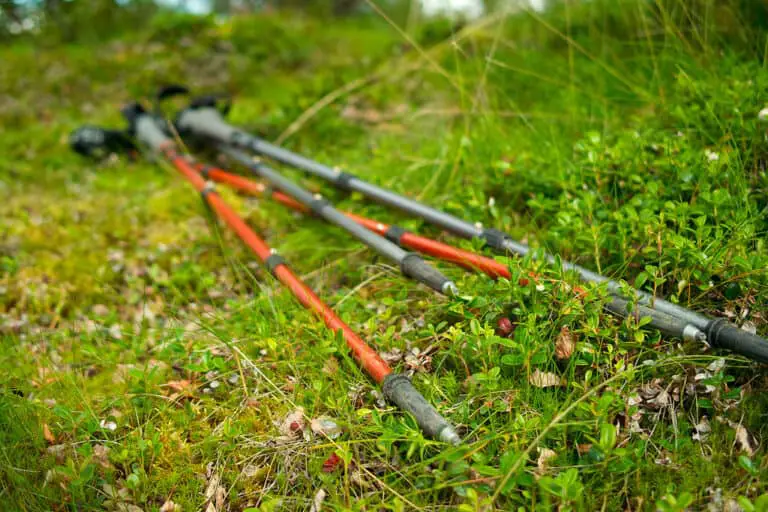Hiking is a fantastic way to explore the great outdoors, but it’s not without its challenges. That’s where hiking poles come in. They’re a hiker’s best friend, offering stability, reducing strain on the knees, and even helping to set a steady pace. But did you know that different hiking pole tips are designed for different terrains?
Which hiking pole tips to use? In this article, we’ll delve into the world of hiking pole tips. We’ll explore the various types available, from carbide to rubber, and discuss which ones are best suited for different hiking environments. Whether you’re a seasoned hiker or just starting out, you’ll find this guide invaluable in choosing the right hiking pole tips for your next adventure.
The Benefits of Using Hiking Poles

You might be asking yourself, “What’s the big deal about hiking poles?” Well, it’s simple. Hiking poles offer a range of benefits that can greatly enhance your hiking experience. They’re not just a fancy gadget which makes you look professional; they’re an essential piece of gear that could turn out to be a gamechanger in your hiking adventures.
Stability. Hiking trails aren’t always even. There’s gravel, there are river crossings, loose rocks, steep ascents, and many other challenges. This is where the hiking poles come in handy. They provide valuable support and balance, especially on treacherous terrain.
Reduced Strain on Knees and Joints. Ever experienced pain in your knees after a long hike? Hiking poles help prevent this. They distribute the weight you’re carrying more evenly, taking some of the pressure off your knees and joints.
Setting a Steady Pace. It’s easy to lose your rhythm while hiking, especially on an uphill trail. Hiking poles help you maintain a steady pace, improving your endurance and reducing fatigue.
With an understanding of how useful hiking poles are, let’s delve into the realm of hiking pole tips. As with poles, there are different types designed for diverse terrain conditions.
Exploring Different Hiking Pole Tips
Hiking pole tips come in different types such as carbide and rubber. Your choice will greatly depend on the kind of trail you’re traversing.
Carbide tips are durable and provide excellent traction especially on icy surfaces. They’re perfect for more challenging terrains where steadiness matters most.
Rubber tips, on the other hand, are best suited for paved or smooth surfaces. They offer a good grip and reduce the noise made by the poles.
In the ensuing section, we’ll further delve into the advantages and disadvantages of each type of hiking pole tip, and provide compelling reasons why one may be better suited to your needs over the other.
Understanding Different Types of Hiking Pole Tips

Now that we’ve established why hiking poles are beneficial, it’s time to delve deeper and gain a better understanding of the different types of hiking pole tips. This information can help you make the right choice based on your individual hiking needs.
Carbide tips are a popular choice among hiking enthusiasts. These tips are incredibly durable and provide excellent traction on most terrains. Here’s why:
- They’re made of tungsten carbide, a super hard compound that resists wear and tear.
- They’re capable of penetrating hard surfaces, ensuring a stable grip even on rocky terrain.
- Their sharp points bite into ice and snow, making them suitable for winter hiking as well.
On the other hand, rubber tips are for those who are environmentally conscious or plan to hike on delicate terrain. They offer a less aggressive grip compared to carbide tips, but they have their own advantages:
- Rubber tips cause less damage to the trail, making them a more eco-friendly option.
- They’re ideal for indoor or paved surfaces as they don’t scratch or damage the ground.
- They provide a maximal surface contact area, which offers stability on slippery or loose terrain.
Finally, if you’re a multi-terrain hiker, switch tips could be your best bet. You can outfit switch tips with different types of caps (like carbide or rubber) based on the current terrain. This makes them incredibly versatile and great for those who don’t want to commit to one type of tip.
Remember, while one tip may excel in one area, it might fall short in another. So it’s crucial to consider where you’ll usually be hiking and what you value most in a hiking pole tip. Look out for the upcoming sections, where I’ll further delve into the pros and cons of each type.
Carbide Tips: Best for Rocky Terrains
As we venture deeper into the nuances of hiking poles, let’s delve into the world of carbide tips – preferred by many for its unmatched durability. If you’re keen on hiking across craggy, uneven terrains, these toughened tips provide exceptional traction and can be your go-to option.
Carbide, known for its strength and hardness, adds durability that’s often absent with other types of hiking pole tips. In effect, they last longer and can easily withstand the high impact and wear of hiking on rocky surfaces. This not only enhances your hiking experience but also ensures more value for your investment.
While carbide tips are designed to help you master rocky terrains with ease, they also come with a built-in shock-absorbing feature. No longer do you have to worry about vibrations traveling up your arm, causing discomfort, or worse, pain. Furthermore, their tapered shape digs into rocks and ice, giving you sturdy support even on slippery grounds.
The carbide tips’ edge truly comes to the forefront during downhill treks. With uneven surfaces and gravity working against you, maintaining a steady pace can be challenging. However, carbide tips deliver solid, reliable contact with the ground, helping you maintain your pace and balance effortlessly even when descending steep slopes.
Rubber Tips: Perfect for Slippery Surfaces

Rubber tips are yet another fantastic option when it comes to selecting the right hiking pole tips. They are an ideal choice if you’re trekking on slippery surfaces such as wet leaves, rocks, and icy paths. With their anti-slip features, rubber tips provide excellent traction ensuring you hike with confidence.
Rubber tips have a soft touch and absorb excess shock quite effectively. That makes them more comfortable for your hands, particularly during long downhills or when you’re covering significant distances. You’ll appreciate the way they can help to alleviate stress on your knees and joints.
What sets rubber tips apart from carbide ones is their versatility. You don’t need to remove them when switching terrains. The rubber material is durable enough to withstand both soft ground like forest trails and hard surfaces like concrete paths. This makes them a promising choice if you’re planning a mixed terrain hike.
Not only do these rubber tips enhance the stability of your hike, but they’re also remarkably simple to use. They fit easily onto the end of most trekking poles. They’re easy to remove too, meaning you can interchange them with other tips, depending on the type of trek you’re undertaking.
Furthermore, rubber tips contribute to the longevity of your hiking poles. By providing a protective layer, they reduce the wear and tear that trekking can have on your poles.
- Rubber tips are anti-slip
- They absorb excess shock
- They’re versatile for various terrains
- They’re easy to use and interchangeable
- They protect your poles from wear and tear
In contrast to carbide tips that are considerable for rocky terrains, rubber ones prove to be a handy alternative for any environment where the grounds are wet, slippery, or hard. The more tools in your hiking arsenal, the better prepared you’ll be for whatever adventure awaits.
Combination Tips: The Versatile Option
In our quest to find the perfect hiking pole tip, we run into combination tips. As the name suggests, these are hybrid versions that combine the strong points of both carbide and rubber tips.
So, what’s the deal with combination tips? It’s pretty simple. They are designed to be all-in-one solutions for hikers who traverse a wide variety of terrains.
The core of a combination tip usually consists of a durable and hard carbide or steel tip. This provides a fantastic grip on rocky, hard surfaces or ice, closely mimicking the performance of a standalone carbide tip. Over this, you have a durable rubber cover. This cover does two things: one, it provides excellent traction on hard, slippery surfaces just like standalone rubber tips. Two, it protects the carbide tip from wear and tear when not needed, increasing overall product longevity.
Sure, combination tips might seem a little overkill for a casual walker. But for serious hikers who are out in all kinds of terrains – from icy paths to moss-covered rocks, these are a game-changer. They save you the hassle of changing tips depending on the terrain and reduce the risk of slipping or tipping over during those tricky transitions.
Moreover, combination tips are easy to interchange with others. The rubber cover can be removed when hitting tougher terrains, exposing the carbide or steel tip underneath. Once back on a slippery surface, the rubber cover can be put back on. This level of control is beneficial on a long hike, letting you adapt your gear to your surroundings.
Indeed, the design and usability of combination tips makes them a versatile option for both novices and seasoned pros of the hiking world.
Conclusion: Which Hiking Pole Tips to Use
We’ve seen that combination tips offer the best of both worlds. They’re the Swiss Army knife of the hiking pole tip world. With their hybrid design, they effectively tackle a range of terrains.
Their carbide or steel core delivers a solid grip on rocky surfaces and ice. The rubber cover, on the other hand, offers excellent traction on slippery ground and doubles up as a shield for the core.
What’s more, they’re user-friendly. You can switch them out with ease, making them a great fit for any hiking adventure. So, if you’re looking for a versatile, all-terrain solution, combination tips are your best bet. They’ll serve both beginners and seasoned hikers well.
Remember, choosing the right hiking pole tips can make all the difference in your hiking experience. So, equip yourself wisely and make every hike a memorable one.
Other suggested articles:

